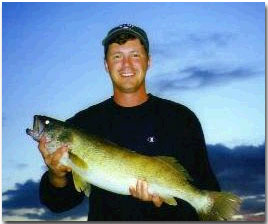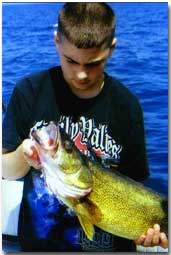Wired Walleye
Wired Walleye
By Dave Adams
Rainy dawn silver in color, built not in a modern factory - where chemists study every polymer compound - but, born of older equipment that spins the cable, which bears the weight of a thousand cars. As an old product and when not supporting the bridge span, stainless steel wire fishing line can be productive and fun.
 Its use, though old and archaic by the standards of today, associates to the techniques of yesterdays' anglers. From what our grandfathers taught us to the latest tactic in our favorite outdoors magazine, we always strive to be better anglers. When old tactics are combined with new ideas, anglers will catch more fish.
Its use, though old and archaic by the standards of today, associates to the techniques of yesterdays' anglers. From what our grandfathers taught us to the latest tactic in our favorite outdoors magazine, we always strive to be better anglers. When old tactics are combined with new ideas, anglers will catch more fish.
Admittedly, many anglers have stated that wire-fishing line can be hard to obtain. But good quality stainless steel wire line can be found. Near the Great Lakes, most bait and tackle stores will stock spools of different poundage or will gladly order line for you. Also, most of the outdoor catalog companies carry stainless steel wire fishing line. Acquiring wire-fishing line can be effortless as well as offering the benefit of low expense and a new feel to fighting a fish.
Using a product that bears a resemblance to something that should be in a piano can be strange. But just as we learned to cast the open-face spinning reel, it soon becomes familiar and pleasurable too use. Flexibility and ease of use in stainless steel fishing wire is measured the same as monofilament - in pound breakage. The most versatile for most open waters such as the Great Lakes is 12 pound. This will give the feel of normal line while offering a sense of assurance that when an extremely large walleye hits - it will be brought to the net.
 Once walleye have finished spawning and begin to feed, a pattern will start to develop. On Lake Erie this generally starts the beginning of June and continues till the end of September. During this time, the plug is combined with wire to present a precise trolling match that consistently yields walleye. Whether using planer boards or flatlining behind the boat, the amount of wire line trolled behind the boat combined with a diving plug will provide exciting moments.
Once walleye have finished spawning and begin to feed, a pattern will start to develop. On Lake Erie this generally starts the beginning of June and continues till the end of September. During this time, the plug is combined with wire to present a precise trolling match that consistently yields walleye. Whether using planer boards or flatlining behind the boat, the amount of wire line trolled behind the boat combined with a diving plug will provide exciting moments.
The amount of line drawn from a spool can be measured by counting the number of times the line guide goes from left to right. While one person holds the line, walk the line back until the line guide moves back and forth one time. Measure the length of line; angling terminology for this is “raps." Often a walleye angler will state, "walleye are hitting at 20 'raps,'" or the line guide has moved back and forth 20 times. The length of line from one line guide movement is 10 feet multiplied by 20 “raps," which is 200 feet.
Many reels are available that will handle wire fishing line with ease. However, any reel that can hold 300 or more yards of line can be used with wire. When stainless steel fishing wire is used, it only needs to be matched with the right lure combination and trolled at the right feeding range.
Catching walleye consistently requires proper depth control and trolling the correct lure. The conventional lure that offers both ease of use and steadfast production is the plug. From deep diving to shallow diving they all offer the same benefit - precise depth control. When fishing a large body of water such as Lake Erie, large deep diving lures such as Long A Bombers or Thundersticks have proven very successful. Although any color or depth might work, a certain combination does seem to provide the best results.
On Lake Erie, trolling a green or fire-tiger deep diving Thunderstick behind a 4-foot leader of 20-pound test monofilament line works well. This setup will reach the depth of 35 feet when trolled behind 320 feet of 12 pound stainless wire. The strongest and most reliable rig is to twist the wire line onto a number 12 barrel swivel. Below the swivel, tie on a 4-foot leader of 20-pound test monofilament line and attach the lure. Most important, by switching to smaller plugs or smaller diving lips - this tactic can be used on any body of water. The amount of line trolled combined with the size of plug will give precise depth control. The correct depth plays an important part in consistently catching fish. But once the fish are found, that pattern will hold true during the entire feeding season.
Combining old techniques with new also works with the time tested worm harness. In addition, when fishing stainless steel wire fishing line, the angler will feel every headshake, dive, and twist. When using a small diving disk and worm harness, trolling takes on a new perspective. Anglers from Lake Michigan to Lake Ontario are familiar with different versions of diving disks. But to keep lures consistently at a certain depths, the Big Jon diving disks has been the most consistent producer. The 1¾-inch disk in any color is adequate. The wire is twisted directly to the diving disk and followed up with a 4-foot leader of 20-pound test monofilament line. Finally, attach a good quality worm harness (when a good size walleye hits a worm harness, it is absorbing most of the shock) and start fishing. By adjusting the amount of line trolled behind the boat, this setup will run to depths of 20 to 35 feet. Start at 180 and gradually move to 220 feet. Once a pattern is found, this depth will produce the entire season.
If undesirable fish start to be a problem, try a old "Captain's" trick; instead of letting the crawler trail from the last hook, "ball" up the crawler on the bottom hook. It might look strange, when hooked 5 or 6 times, but walleye really devour it.
Traditional open water trolling methods produce. Nevertheless, water clarity, fishing pressure, and lower walleye numbers dictate what changes to make in order to be successful. For all day action and size of fish, wire fishing line combined with time-honored trolling tactics can provide an unforgettable day.
|
